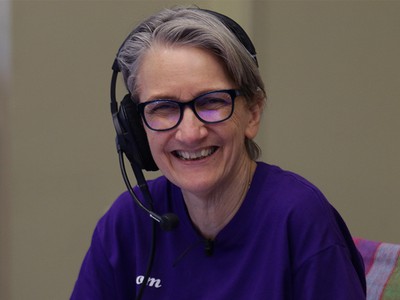Leave it to nearly 200 Presbyterian mid council moderators and vice moderators to have a good time while honing their parliamentary procedure skills.
The Rev. Tricia Dykers-Koenig, associate director for Mid Council Relations in the Office of the General Assembly who lent her considerable parliamentary skills to the 224th General Assembly (2020), designed Friday’s training to give the mid council moderators real world scenarios, which they discussed in small groups, and three fun pop quizzes, which they answered online.
Some sample questions:
- Someone makes a motion without being recognized by the moderator. Is the moderator required to recognize the motion? Eighty-eight percent of moderators said no, but Dykers-Koenig said it depends. Motions including dividing the assembly or requesting an order of the day can interrupt what’s going on.
- Which phrase is proper: “So moved,” “Are there any abstentions?” “Are you ready for the question?” or “Opposed, same sign”? The correct answer is the third one, she said. “So moved” can be vague, and abstentions aren’t something for the moderator to count. As for the fourth choice, “You won’t see those words blessed” in “Robert’s Rules of Order, Newly Revised, 12th Edition,” which is, she noted, correctly abbreviated RONR, for “Rules of Order Newly Revised.”
- What does “dilatory” mean? The choices were “In order,” “Obstructionist,” “Related to pickles” or “Prompt.” It’s choice 2, of course, and one moderator wrote “Is that kosher?” while the voting was being conducted. Dykers-Koenig defined “dilatory” as “someone using the rules to obstruct what the body wants to do. It basically means ‘obnoxious,’” she said. Moderators who recognize dilatory behavior “have the authority to say, ‘That’s out of order under the circumstances,’” she said.
- To kill a motion for the remainder of the session, the correct motion is to: postpone indefinitely, table, postpone indefinitely or move the previous question. While half the participants chose “table,” “if you want to wait until next time, it is ‘postpone definitely,’” Dykers-Koenig said. “’Table’ is a motion that should only be used if something comes up that needs to be dealt with immediately. It’s to say, ‘The pizza is here, and we need to eat it while it’s hot. We will table the motion, and after we eat, we will take it off the table.’”
- A quorum is: at least a majority of the membership, the number of members that must be present in order to conduct business, determined by the stated clerk or all of the above. Sixty-three percent correctly selected the second option, although if the body hasn’t set a quorum another way, it’s the majority of membership. The Book of Order allows for smaller quorums, Dykers-Koenig noted. And it’s not necessary for the moderator to ask the stated clerk if a quorum is present. “It’s the moderator who decides if there’s a quorum present,” she said, “and you don’t need to say anything about it.”
In between the trivia questions, moderators discussed scenarios that could or actually have happened. In one, a member of the body wants to reconsider an item that’s been defeated after many people have left the meeting. In another, moderators were asked how to docket an item they know will be controversial.
In their comments following the training session, moderators did not hide their enthusiasm.
“This has been the BEST presentation thus far,” said one. “It has been the most relevant, interactive and fun. Kudos, Tricia.”
“Really, really good pedagogy for online learning here,” said another.
And this, from the Co-Moderator of the 224th General Assembly (2020), the Rev. Gregory Bentley: “Great activity and great facilitation.”

